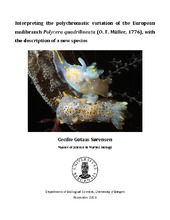| dc.description.abstract | The polychromatic variability exhibited by the dorid nudibranch species Polycera quadrilineata (O. F. Müller, 1776) (Family Polyceridae) has long fascinated marine scientists. The species was originally described from the Oslofjord (Drøbak) in Norway and is distributed between Lofoten (Northern Norway) throughout the Atlantic to the Iberian Peninsula, the Mediterranean Sea, and the archipelagos of the Azores, Madeira, and Canary Islands, where it often occurs in kelp forests in the vicinity of its bryozoan-prey. The increasing detection of cryptic species in nudibranch gastropods, and other marine invertebrates, has raised the question whether the chromatic variability within P. quadrilineata could hide cryptic lineages or still be consistent with the hypothesis of a single entity. In order to test this hypothesis, samples from across the geographical range of P. quadrilineata together with representatives from worldwide species, with a focus on the Atlantic diversity, were gathered and studied using an integrative taxonomic approach. Morpho-anatomical characters were investigated by light -and scanning electron microscopy, and novel sequences (66) of the universal barcoding mitochondrial gene cytochrome c oxidase subunit I (COI) were generated and gathered from DNA databases (47). Bayesian molecular phylogenetic analysis using MrBayes, the Automatic Barcode Gap Discovery species delimitation method, and a haplotype network analysis using the PopArt software were used to aid delimit species and infer relationships. The results revealed the existence of a second polychromatic cryptic species within P. quadrilineata, here named Polycera n. sp., so far only known from Norway where it is sympatric with P. quadrilineata. The genetic distance between the two species was estimated to be 9.6–12.4% (COI uncorrected p-distance). Chromatically Polycera n. sp. differs by exhibiting a black dotted or patchy dotted pattern occasionally with orange/brown blotches, but never black stripes like P. quadrilineata. However, the two species share a common colour pattern defined by a whitish base and yellow/orange pigmentation. Anatomically, Polycera n. sp. differs by having a weaker labial cuticle, a smaller radula with fewer rows, and only four marginal teeth (instead of the five present in P. quadrilineata), and a reproductive system with a shorter penis armed with needle-like and hook-shaped penile spines (whereas P. quadrilineata only has needle-like spines). | en_US |
